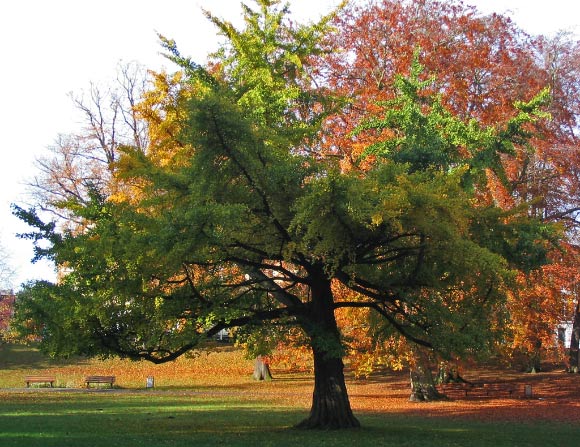A team of scientists in China has sequenced the genome of Ginkgo biloba, the oldest living tree species.
Ginkgo biloba is a widely popular tree that is native to China and has been cultivated for well over a millennium.
In Asia, ginkgo is used medicinally and its seeds are also a popular cuisine item. In the West, ginkgo leaf extracts are commonly used for a variety of folk remedies including as a treatment for improving cognitive function.
Today’s ginkgo is the sole surviving species of an ancient group (Ginkgophytes) of seed plants that may even date from the Permian (up to 270 million years ago).
The genus Ginkgo itself goes back to the Jurassic period, roughly 170 million years ago.
As a living fossil, Ginkgo biloba has changed little in morphology from its extinct relatives. A single tree can live as long as 1,000 years and grow to a height of 120 feet. It has short branches with fan-shaped leaves and inedible fruits that smell bad. The fruit has an inner seed, which may be poisonous.
To study the ginkgo’s extraordinary biology at a genetic and molecular level, sequencing its genome was high up on the wish list of plant biologists. However, because of its size as well as the presence of an enormous number of repeat sequences, assembling the whole genome sequence would be a difficult task.
According to the team, led by Dr. Wenbin Chen from the Beijing Genomics Institute (BGI), the ginkgo genome stretches over more than 10 GB, which is 80 times larger than the genome of the model plant Arabidopsis thaliana.
The tree’s genome is also larger than other plant species known for extremely big genomes, such as maize or orchids.
“A huge amount of raw data (2 TB) was generated, and the computing capability for genome assembly was challenged by both the huge data and the remarkably high proportion of repetitive sequences. So an incredible amount of memory was required,” Dr. Chen said.
“The large genome of ginkgo may have resulted from whole genome duplication and insertion of a remarkably high proportion of repetitive sequences, at least 76.58%, and the longest introns among all sequenced species due to insertions of transposable elements.”
“Ginkgo represents one of the five living groups of seed plants, and has no living relatives,” said team member Prof. Yunpeng Zhao, from Zhejiang University.
“Such a genome fills a major phylogenetic gap of land plants, and provides key genetic resources to address evolutionary questions like phylogenetic relationships of gymnosperm lineages, evolution of genome and genes in land plants, innovation of developmental traits, evolution of sex as well as history of demography and distribution, resistance and conservation of ginkgo.”

A Ginkgo biloba leaf (Eocene, some 49 million years old) with insect herbivory from Klondike Mountain Formation, Ferry County, Washington. Image credit: Stonerose Interpretive Center Collection / Kevmin / CC BY-SA 3.0.
The team is also fascinated by the ginkgo’s resilience under adverse conditions — it is worth noting that ginkgo trees were one of the few living things to survive the blast of the atomic bombing of Hiroshima.
This hardiness likely helped the ginkgo survive periods of glaciation in China that killed many other species, and may also promote the longevity of individual trees.
The ginkgo is also able to defend itself against a wide range of attackers, employing an arsenal of chemical weapons against insects, bacteria and fungi.
To better understand the ginkgo’s defensive systems, the researchers analyzed the repertoire of genes present in its genome that are known to play a role in fending off attackers.
An initial analysis of the tree’s more than 40,000 predicted genes showed extensive expansion of gene families that provide for a variety of defensive mechanisms.
Genes that enable resistance against pathogens are often duplicated.
Additionally, ginkgo has a double-knockout punch in its fight against insects by synthesizing chemicals that directly fight insects and by releasing volatile organic compounds that specifically attract enemies of plant-eating insects.
These findings indicated that having multiple mechanisms — the expansion of gene families, higher doses of specific genes, and versatility in its defense genes — might be linked to the ginkgo’ extraordinary resilience.
The results will be published online this week in the journal GigaScience.
_____
Rui Guan et al. Draft genome of the living fossil Ginkgo biloba. GigaScience, published online November 22, 2016; doi: 10.1186/s13742-016-0154-1








